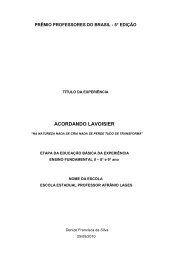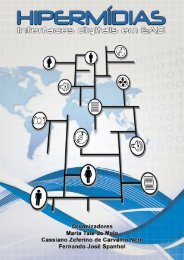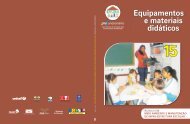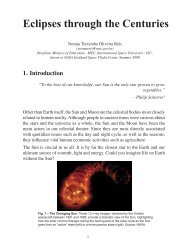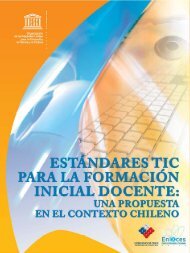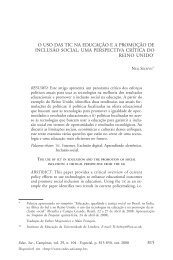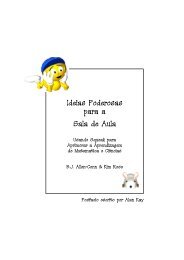BIO-CULTURAL COMMUNITY PROTOCOLS - Portal do Professor
BIO-CULTURAL COMMUNITY PROTOCOLS - Portal do Professor
BIO-CULTURAL COMMUNITY PROTOCOLS - Portal do Professor
You also want an ePaper? Increase the reach of your titles
YUMPU automatically turns print PDFs into web optimized ePapers that Google loves.
PART II / CHAPTER 5<br />
2. Bio-cultural Community Protocols and Protected Areas<br />
BCPs can be of great use in the two governance types of<br />
protected areas in which ILCs have a say in decision-making:<br />
CMPAs, protected areas in which the governance is shared<br />
between communities and other actors, and ICCAs,<br />
protected areas governed by ILCs themselves.<br />
2.2 Bio-cultural Community Protocols<br />
and Co-managed Protected Areas<br />
CMPAs can be defined as “officially designated protected areas<br />
where decision-making power is shared between state<br />
agencies and other partners, including ILCs, and/or NGOs and<br />
individuals or private sector institutions”. 10<br />
CMPAs are based upon a negotiated joint decision-making<br />
approach and involve some degree of power-sharing and fair<br />
distribution of benefits among all institutional actors.<br />
Co-management arrangements involving ILCs often emerge<br />
when territories under their occupation or management,<br />
including ICCAs, are brought under the protected areas<br />
network either at the insistence of the communities or<br />
through government initiative. 11<br />
BCPs can be a valuable instrument to empower ILCs to<br />
participate effectively in the decision-making and<br />
management of CMPAs. First of all, the process of developing<br />
a BCP is an opportunity for the community to assess and<br />
articulate the bio-cultural values associated with the area<br />
under protection and to develop its own vision of its desired<br />
future. The BCP can also serve as a basis for dialogue with<br />
other institutions involved in the management of the protected<br />
areas by demonstrating the contribution of the community’s<br />
TK to the conservation of the area and clarifying the needs<br />
of the community to access natural resources. Furthermore,<br />
the process of drafting a BCP raises the community’s awareness<br />
about its rights under national and international law, which<br />
is essential to negotiating towards the equitable sharing of<br />
management authority. Finally, a BCP can clarify the<br />
expectations of the community for the sharing of benefits<br />
arising from the protected area, such as tourism revenues.<br />
<strong>BIO</strong>-<strong>CULTURAL</strong> <strong>COMMUNITY</strong> <strong>PROTOCOLS</strong> AND PROTECTED AREAS<br />
A major challenge for effective co-management arrangements<br />
involving ILCs is the recognition and co-existence of local<br />
or customary and governmental or formal institutions, policies<br />
and practices. By referring explicitly to the customary<br />
governance institutions, management rules and values of<br />
the community, BCPs can further facilitate the institutional<br />
and inter-cultural dialogue.<br />
In some cases, lands and resources traditionally inhabited and<br />
used by ILCs have been incorporated into official protected<br />
areas without their consent or agreement. In such situations,<br />
BCPs could assist communities in demanding the restoration<br />
of traditional land and resource rights over all or part of an<br />
official protected area.<br />
Co-management agreements are based in part on the<br />
recognition that ILCs have TK that allow them to play a<br />
significant role in protected area management. Ideally, these<br />
agreements should explicitly identify the specific areas and<br />
resources ILCs can access, and under what terms and<br />
conditions. For effective negotiation and proper monitoring<br />
of agreements involving TK, community ethno-ecological<br />
studies are required. Best practice dictates that community<br />
researchers conduct their own research, often in collaboration<br />
with representatives of external agencies, and include a<br />
variety of metho<strong>do</strong>logies such as household surveys,<br />
mapping, biological collections, and detailing of TK of<br />
resources and landscapes.<br />
Since the results of this community-based research will be<br />
disclosed to some extent to collaborating academics,<br />
government staff (such as rangers and wardens from park<br />
agencies) and civil society throughout the course of<br />
negotiating co-management decisions, a large corpus of<br />
information about local beliefs, knowledge, practices,<br />
and innovations will become publicly available.<br />
Before any collaborative research begins, the community<br />
must ensure some degree of protection of its intellectual<br />
property and traditional resources rights through the<br />
10. Kothari, Ashish, Collaboratively Managed Protected Areas. In: Managing Protected Areas, a Global Guide. Michael Lockwood, Graeme L. Worboys and<br />
Ashish Kotari (editors). IUCN, Earthscan, Lon<strong>do</strong>n, 2006, p. 528.<br />
11. Ibid.<br />
54





